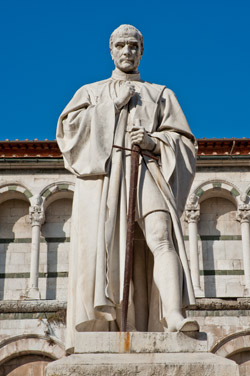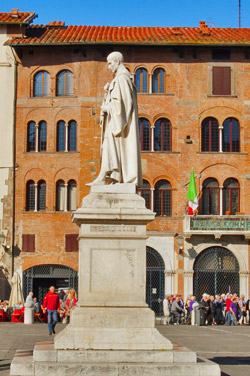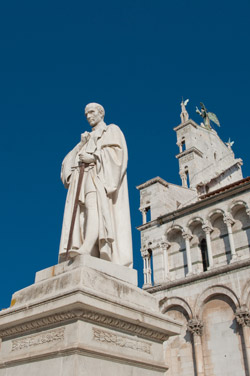Francesco Burlamacchi «primo martire dell'unità italiana»
Romano Silva
L'individuazione di Francesco Burlamacchi come primo martire dell'unità italiana che troviamo nel decreto del 1859 si fonda sulle idee diffuse da un volumetto pubblicato da Carlo Minutoli nel 1844. Fino a quel momento la figura del Burlamacchi era stata ben lungi dal rappresentare quell'immagine di "martire" assegnatagli dalla storiografia dell'Ottocento. Nella Cronica, iniziata nel 1582 da Salvatore Dalli, si dice ad esempio, e per secoli questa è stata a Lucca un'opinione diffusa, che Francesco Burlamacchi <<huomo di strana fantasia e di natura contraria a gl'altri tutti della sua Casa>> aveva agito per procurare fama al proprio nome e non si nasconde che il progetto, se fosse riuscito,<<saria stata opera degna di eterna memoria>>.
Il piano di muovere con le milizie del contado verso Pisa e di rovesciarvi il potere mediceo, per marciare poi su Firenze, non si nutrì della pratica delle armi ma piuttosto dell'ideale di libertà che, pur nascendo dalla tradizionale fede repubblicana della cultura lucchese, acquista un significato molto più ampio e disinteressato alla luce delle Storie romane di Tito Livio che il Burlamacchi leggeva con avidità.
L'esecuzione del monumento a Francesco Burlamacchi fu commissionata allo scultore Ulisse Cambi (Firenze 1807-1895) che lo portò a termine con sollecitudine, e la statua, eretta in piazza San Michele, fu inaugurata il 14 settembre 1863, alle ore nove del mattino. La coincidenza dell'inaugurazione con le celebrazioni liturgiche della festa di Santa Croce non è casuale e sottolinea i contrasti che a Lucca si andavano profilando tra la cultura cattolica e quella ispirata agli ideali risorgimentali e massonici. Il monumento al Burlamacchi, eretto subito dopo la costituzione del Regno d'Italia, costituisce il primo e il più significativo esempio dell'iconografia politica risorgimentale a Lucca.
La statua, che per la dimensione prevalente della piazza avrebbe dovuto essere posta con le spalle ad est e il volto ad ovest, cioè nella stessa posizione della basilica di San Michele in Foro, fu invece collocata con le spalle rivolte alla chiesa in segno di sdegnata opposizione al potere temporale. In un opuscolo pubblicato anonimo nel 1863, in occasione dell'erezione del monumento, si dice tra l'altro che <<fortemente lo crucciava il vedere molte città delle Romagne e dell'Umbria condannate a servire umilmente all'ambizione dei papi>>.
Francesco Burlamacchi <<first martyr of the Unity of Italy>>
Romano Silva
The identification of Francesco Burlamacchi as the first martyr of the Unity of Italy which appears in the decree of 1859, is based on ideas spread by a booklet published in 1844 by Carlo Minutoli. Until that time the figure of Burlamacchi had been a far cry from impersonating the image of a "martyr", assigned to him in the 19th Century by historiography. In the "Cronica", launched in 1582 by Salvatore Dalli, it is stated for example, remaining an opinion widely held for centuries in Lucca, that Francesco Burlamacchi «a man of strange imagination with a nature contrary to all the others in his House» had acted to win fame for himself and it is not withheld that this intent, had it succeeded, «would have been an accomplishment worthy of eternal memory».
The plan to advance with a force of local troops on Pisa and overthrow the Medicean rule there, then marching to Florence, was not fuelled by experience in the use of arms but rather by the ideal of freedom which, although rooted in the traditional republican faith held in Lucca, acquires a much wider-reaching and disinterested significance in the light of the "Storie romane" by Tito Livio which Burlamacchi avidly read.
Works on the monument to Francesco Burlamacchi were commissioned to the sculptor Ulisse Cambi (Florence 1807-1895) who diligently completed his task. The statue, placed in piazza San Michele, was inaugurated on 14 September 1863, at nine o'clock in the morning. The coincidence of the inauguration with church celebrations for the Feast of Santa Croce is not by chance and emphasises the contrasts developing in Lucca between the catholic culture and that inspired by the ideals of the Risorgimento and Masonry. The monument to Burlamacchi, installed immediately after the Kingdom of Italy was established, represents the first and most significant example of political iconography of the Risorgimento in Lucca.
Because of the predominating size of the square, the statue should have been placed with its back to the East and thus facing West, that is in the same position as the basilica of San Michele in Foro. It was however positioned with its back to the church, in sign of indignant opposition to temporal power. In a booklet published anonymously in 1863, to mark the monument's placing, it is moreover stated that «he was sorely distressed to see many cities in the Romagnas and Umbria condemned to humbly serve the ambition of the Popes».
 DOCUMENTI PDF
DOCUMENTI PDF
Francesco Burlamacchi «primo martire dell'unità italiana»
IL MONUMENTO

Monumento a Francesco Burlamacchi

Particolare del monumento


